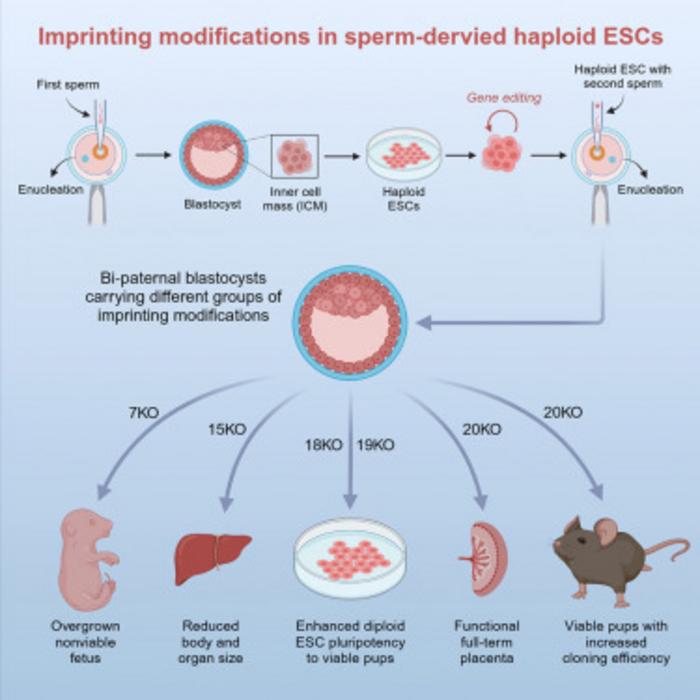A groundbreaking study published in January 2025 marks a significant leap forward in the field of reproductive biology. A team of stem cell scientists successfully engineered a bi-paternal mouse—a remarkable achievement that enabled a mouse to have two male parents and live to adulthood. This unprecedented development, detailed in the leading journal Cell Stem Cell, showcases the potential of advanced gene editing techniques in surmounting challenges associated with unisexual reproduction in mammals, an intriguing area of research that has captivated scientists for years.
Imprinting genes were identified as a fundamental barrier to unisexual reproduction in mammals because they control the expression of genes based on their parental origin. In simpler terms, these genes can exhibit parent-specific expression patterns, leading to complications when hypothetical embryos are created through unisexual means. The investigators believed that addressing the imprinting abnormalities would provide a pathway to successful development in bi-paternal embryos. The outcomes of their targeted approach illuminated a resilient pathway for stem cell and regenerative medicine.
In a set of carefully orchestrated experiments, researchers individually modified 20 critical imprinting genes using a combination of techniques, including gene deletions, frameshift mutations, and edits to regulatory regions. This sophisticated genetic manipulation not only facilitated the formation of bi-paternal embryos that could mature into adulthood, but also produced stem cells exhibiting more stable pluripotency—an essential characteristic for the development of various cell types. The innovative approach has significant implications for future regenerative medicine applications, suggesting avenues for creating healthier stem cell lines and enhancing cloning efficiency.
Furthermore, researchers expressed interest in extending their experimental approaches to larger animal models, such as monkeys. However, this ambition is complicated by the genetic differences in imprinting gene combinations between species. The successful translation of this technology from mice to more complex organisms requires thorough understanding and substantial effort to navigate these variances.
Despite its futuristic implications for human health, the research is tempered by ethical guidelines governing stem cell research. The International Society for Stem Cell Research maintains strict protocols that prohibit heritable genome editing for reproductive purposes due to safety concerns. As a result, applications of this groundbreaking technology in human medicine remain speculative at best.
This research is positioned at the intersection of scientific innovation and ethical considerations, showcasing how advancements in genetic engineering can reshape our understanding of reproductive biology. The implications of bi-paternal reproduction go beyond the laboratory; they prompt critical discussion about what can be achieved through science and the extent to which we should pursue such possibilities.
In summary, this pioneering research on creating bi-paternal mice opens new avenues in the study of genetics, reproductive biology, and regenerative medicine. By confronting well-established barriers, the authors not only advance our scientific knowledge but also potentially redefine the boundaries of mammalian reproduction. As the team continues its explorations, the scientific community watches with keen interest, eager to see how these findings will evolve and what implications they may hold for future generations.
The profound ethical implications of this research provide a backdrop to its promising scientific potential. As researchers probe the capacity for unisexual reproduction, they must grapple with the moral responsibilities that accompany such innovations. The advancements in this field signal a new era, prompting reflections on how far science can go in understanding and manipulating the very fabric of life itself.
Ultimately, the exploration of imprinting gene modifications in bi-paternal mice represents a watershed moment in stem cell research, one that reinforces the interconnectedness of scientific discovery and ethical inquiry. This journey aims not just to solve existing problems but to anticipate the societal implications that accompany every breakthrough.
As more studies build upon this foundation, the discourse surrounding reproductive technology will undoubtedly expand, encouraging rigorous debates within the fields of science, ethics, and social policy. The future of bioparental reproduction resonates with the promise of innovation, coupled with the need for responsible exploration of capabilities that nature has yet to fully reveal.
This remarkable achievement in genetic engineering paves the way for future inquiries in unisexual reproduction. The road ahead will be filled with opportunities for further discovery and the challenges of navigating the ethical landscape that these developments evoke.
Subject of Research: Animals
Article Title: Adult bi-paternal offspring generated through direct modification of imprinted genes in mammals
News Publication Date: 28-Jan-2025
Web References:
References:
Image Credits: Current Biology, Li et al.
Keywords
Stem cell development, Stem cell research, Embryonic stem cells, Regulatory genes, Pluripotent stem cells, Animal research, Rodents, Gene targeting, Genome editing.
Tags: advancements in reproductive biologybi-paternal mouse researchchallenges of unisexual reproductiondevelopmental biology innovationsfuture of reproductive technologygene editing techniques in mammalsgenetic complications in reproductionimplications of bi-parental offspringimprinting genes and gene expressionstem cell science breakthroughstwo male parents reproductionWei Li research team





